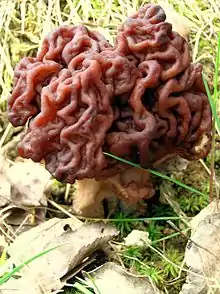Morchella
Morchella, the true morels, is a genus of edible sac fungi closely related to anatomically simpler cup fungi in the order Pezizales (division Ascomycota). These distinctive fungi have a honeycomb appearance due to the network of ridges with pits composing their caps. Morels are prized by gourmet cooks, particularly in French cuisine. Due to difficulties in cultivation, commercial harvesting of wild morels has become a multimillion-dollar industry in the temperate Northern Hemisphere, in particular North America, Turkey, China, the Himalayas, India, and Pakistan, where these highly prized fungi are found in abundance.
| Morel | |
|---|---|
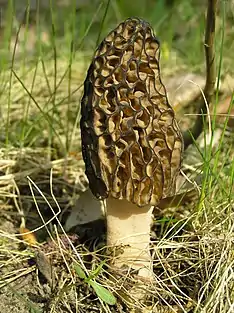 | |
| A black morel in Poland | |
| Scientific classification | |
| Kingdom: | Fungi |
| Division: | Ascomycota |
| Class: | Pezizomycetes |
| Order: | Pezizales |
| Family: | Morchellaceae |
| Genus: | Morchella Dill. ex Pers. : Fr. (1794) |
| Type species | |
| Morchella esculenta | |
| Species | |
|
~70 worldwide (see text) | |
| Synonyms[1] | |
Typified by Morchella esculenta in 1794, the genus has been the source of considerable taxonomical controversy throughout the years, mostly with regard to the number of species involved, with some mycologists recognising as few as three species and others over thirty. Current molecular phylogenetics suggest there might be over seventy species of Morchella worldwide, most of them exhibiting high continental endemism and provincialism.
The genus is currently the focus of extensive phylogenetic, biogeographical, taxonomical and nomenclatural studies, and several new species have been described from Australia, Canada, Cyprus, Israel, Spain, and Turkey.
Early history
Morchella Dill. ex Pers. : Fr. was typified by Christiaan Hendrik Persoon in 1794,[2] with Morchella esculenta designated as the type species for the genus. Among early pioneers who took an interest in the genus, were mycologists Julius Vincenz von Krombholz and Émile Boudier, who, in 1834[3] and 1897[4] respectively, published several species and varieties, accompanied by meticulously illustrated iconographic plates. The seminal taxon Morchella elata, whose true identity still remains unresolved,[5][6] was described by Elias Fries in 1822, from a fir forest in Sweden.[7] Other classical, early-proposed names include Morchella deliciosa, also described by Fries in 1822, Morchella semilibera, the half-free morel, originally described by de Candolle and sanctioned by Fries in 1822,[7] Morchella vulgaris, which was recombined by Samuel Gray as a distinct species in 1821[8] following a forma of M. esculenta previously proposed by Persoon, and Morchella angusticeps, a large-spored species described by American mycologist Charles Peck in 1887.[9] Morchella purpurascens, the purple morel, was first described by Boudier as a variety of M. elata in 1897 based on an 1834 plate by Krombholz, and was recombined as a distinct species in 1985 by Emile Jacquetant.[10][11] Morchella eximia, a globally-occurring fire-associated species was also described by Boudier in 1910.[12] The old, widely applied name Morchella conica,[13] featuring in many field guides and literature across several countries, has been shown by Richard and colleagues to be illegitimate.[5]
Systematic classification
Phylogeny
Early phylogenetic analyses supported the hypothesis that the genus comprises only a few species with considerable phenotypic variation.[14][15][16] Subsequent multigenic DNA studies, however, have revealed more than a dozen genealogically distinct species in North America and at least as many in Europe.[17][18][19][5] DNA studies revealed three discrete clades, or genetic groups, consisting of the "white morels" (Morchella rufobrunnea and Morchella anatolica), the "yellow morels" (Morchella esculenta and others), and the "black morels" (Morchella elata and others).[18] The fire-associated species Morchella tomentosa, commonly known as the "gray morel", is distinct for its fine hairs on the cap ridges and unique sclerotia-like underground structures, and may also deserve its own clade based on DNA evidence.[20][21][22] Within the yellow and black clades, there are dozens of distinct species, most endemic to individual continents or regions.[18] This species-rich view is supported by studies in Western Europe,[23] Turkey,[24] Cyprus,[25] Israel,[26] China,[27] Patagonia[28] and the Himalayas.[29]
Taxonomy
The fruit bodies of Morchella species are highly polymorphic, varying in shape, color and size, while in many cases they do not exhibit clear-cut distinguishing features microscopically; this has historically contributed to uncertainties in taxonomy.[30][31][32][6] Discriminating between the various taxa described, is further hindered by uncertainty over which of these are truly biologically distinct. Remarkably, some authors in the past had suggested that the genus contains as few as 3 to 6 species,[33][34][35][36][37] while others recognised as many as 34.[4][10][38] Efforts to clarify the situation and re-evaluate old classical names (such as Morchella elata and others) in accordance to current phylogenetic data, have been challenging, due to vague or ambiguous original descriptions and loss of holotype material.[5][39] In 2012, the simultaneous description of several new taxa from Europe by Clowez[38] and North America by Kuo and colleagues[40] resulted in several synonymities further complicating matters, until a transatlantic study by Richard and colleagues resolved many of these issues in 2014.[5] The genus is currently undergoing extensive re-evaluation with regards to the taxonomic status of several species.
Species
About 80 species of Morchella were described until the turn of the century (http://www.indexfungorum.org/), a number of which were later shown to be illegitimate or synonyms.[5] As molecular tools became widely available in the new millennium, a revived interest in the genus commenced and several new species were proposed. In 2008 Kuo described Morchella tomentosa from burned coniferous forests in western North America.[21] In 2010 Işiloğlu and colleagues described Morchella anatolica,[41] a basal species from Turkey later shown to be sister to Morchella rufobrunnea. A study by Clowez described over 20 new species in 2012,[38] while later in the same year, another study by Kuo and colleagues described 19 species from North America.[40] However, several of these newly proposed names later turned out to be synonyms.[5] An extensive taxonomical and nomenclatural revision of the genus provided by Richard and colleagues in 2014, applied names to 30 of the genealogical lineages recognized so far and clarified several synonymities.[5] Also in 2014, Elliott and colleagues described Morchella australiana from sclerophyll forests in Australia,[42] while Clowez and colleagues described Morchella fluvialis from riparian forests in Spain.[43]
In 2015, Loizides and colleagues clarified the taxonomy of Morchella tridentina, a cosmopolitan species described under many names, and recombined Morchella kakiicolor as a distinct species.[39] Later in the same year, Clowez and colleagues described Morchella palazonii from Spain,[44] while Voitk and colleagues described Morchella laurentiana from Canada and Morchella eohespera, a cosmopolitan species present in several continents.[45] In an extensive phylogenetic and morphological study from Cyprus in 2016, Loizides and colleagues added two more Mediterranean species, Morchella arbutiphila and Morchella disparilis, and resurrected Morchella dunensis as an autonomous species.[25] In the same year, Taşkın and colleagues described four of the previously unnamed phylospecies from Turkey: Morchella conifericola, Morchella feekensis, Morchella magnispora and Morchella mediteterraneensis.[46]
Section Rufobrunnea
Section Morchella
- Morchella americana
- Morchella castaneae
- synonyms: Morchella brunneorosea, Morchella brunneorosea var. sordida
- Morchella diminutiva
- Morchella dunensis
- synonyms: Morchella esculenta f. dunensis, Morchella andalusiae
- Morchella esculenta
- synonyms: Morchella pseudoumbrina, Morchella pseudoviridis
- Morchella fluvialis
- Morchella galilaea
- Morchella palazonii
- Morchella prava
- Morchella sceptriformis
- synonym: Morchella virginiana
- Morchella steppicola
- Morchella ulmaria
- synonym: Morchella cryptica
- Morchella vulgaris
- synonyms: Morchella acerina, Morchella anthracina, Morchella lepida, Morchella robiniae, Morchella spongiola
Section Distantes
- Morchella angusticeps
- Morchella arbutiphila
- Morchella australiana
- Morchella brunnea
- Morchella conifericola
- Morchella deliciosa
- synonym: Morchella conica
- Morchella disparilis
- Morchella dunalii
- synonym: Morchella fallax
- Morchella elata
- Morchella eohespera
- Morchella eximia
- synonyms: Morchella anthracophila, Morchella carbonaria, Morchella septimelata
- Morchella eximioides
- Morchella exuberans
- synonym: Morchella capitata
- Morchella feekensis
- Morchella iberica[47]
- Morchella importuna
- Morchella kakiicolor
- Morchella laurentiana
- Morchella magnispora
- Morchella mediteterraneensis
- Morchella populiphila
- Morchella pulchella
- Morchella punctipes
- Morchella purpurascens
- synonyms: Morchella elata var. purpurascens, Morchella conica, Morchella conica var. purpurascens, Morchella conica var. crassa
- Morchella semilibera
- synonyms: Morchella gigas, Morchella gigas var. tintinnabulum, Morchella hybrida, Morchella undosa, Morchella varisiensis, Morchella esculenta var. crassipes, Phallus gigas, Eromitra gigas, Phallus undosus, Phallus crassipes, Mitrophora hybrida, Mitrophora hybrida var. crassipes, Ptychoverpa gigas, Helvella hybrida
- Morchella septentrionalis
- Morchella sextelata
- Morchella snyderi
- Morchella tomentosa
- Morchella tridentina
- synonyms: Morchella quercus-ilicis, Morchella frustrata, Morchella elatoides, Morchella elatoides var. elagans, Morchella conica var. pseudoeximia
Unresolved classification
- Morchella anteridiformis
- Morchella apicata
- Morchella bicostata
- Morchella conicopapyracea
- Morchella crassipes
- Morchella deqinensis
- Morchella distans
- Morchella guatemalensis
- Morchella herediana
- Morchella hetieri
- Morchella hortensis
- Morchella hotsonii
- Morchella hungarica
- Morchella inamoena
- Morchella intermedia
- Morchella meiliensis
- Morchella miyabeana
- Morchella neuwirthii
- Morchella norvegiensis
- Morchella patagonica
- Morchella patula
- Morchella pragensis
- Morchella procera
- Morchella pseudovulgaris
- Morchella rielana
- Morchella rigida
- Morchella rigidoides
- Morchella smithiana
- Morchella sulcata
- Morchella tasmanica
- Morchella tatari
- Morchella tibetica
- Morchella umbrina
- Morchella umbrinovelutipes
- Morchella vaporaria
Ecology, phenology and distribution
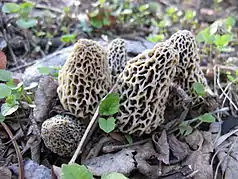
The ecology of Morchella species is not well understood. Many species appear to form symbiotic or endophytic relationships with trees,[48][49][50][51] while others appear to act as saprotrophs.[20][50] Yellow morels (Morchella esculenta and related species) are more commonly found under deciduous trees rather than conifers, while black morels (Morchella elata and related species) are mostly found in coniferous forests, disturbed ground and recently burned areas.[38][25][52][53] Morchella galilaea,[54] and occasionally Morchella rufobrunnea,[26][55][39] appear to fruit in the autumn or winter months rather than spring, which is the typical fruiting season for morels.
Tree species associated with Morchella vary greatly depending on the individual species, continent, or region. Trees commonly associated with morels in Europe and across the Mediterranean include Abies (fir), Pinus (pine), Populus (poplar), Ulmus (elm), Quercus (oak), Arbutus (strawberry trees), Castanea (chestnut), Alnus (alder), Olea (olive trees), Malus (apple trees) and Fraxinus (ash).[38][25][39][19] In western North America morels are often found in coniferous forests, including species of Pinus (pine), Abies (fir), Larix (larch), and Pseudotsuga (Douglas-fir), as well as in Populus (cottonwood) riparian forests.[56][40] Deciduous trees commonly associated with morels in the northern hemisphere include Fraxinus (ash), Platanus (sycamore), Liriodendron (tulip tree), dead and dying elms, cottonwoods and old apple trees (remnants of orchards).[40] Due to their springtime phenology (March–May), morels are hardly ever found in the vicinity of common poisonous mushrooms such as the death cap (Amanita phalloides), the sulphur tuft (Hypholoma fasciculare), or the fly agaric (Amanita muscaria).[57] They can, however, occur alongside false morels (Gyromitra and Verpa species) and elfin saddles (Helvella species), which also appear in spring.
Efforts to cultivate morels at a large scale have rarely been successful and the commercial morel industry relies on the harvest of wild mushrooms.[56]
Association with wildfire
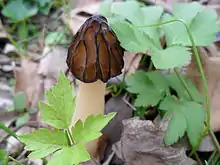
Certain Morchella species (M. eximia, M. importuna, M. tomentosa and others) exhibit a pyrophilic behaviour and may grow abundantly in forests which have been recently burned by a fire.[58][59] Moderate-intensity fires are reported to produce higher abundances of morels than low- or high-intensity fires.[22] This is caused by the soil becoming more alkaline as the result of wood ash combining with water and being absorbed into the soil which triggers the morels to fruit. Alkaline soil conditions which trigger fruiting has been observed and exploited with small scale commercial cultivation of morels.[60][20][58] Where fire suppression is practiced, morels often grow in small amounts in the same spot year after year. If these areas are overrun by wildfire they often produce a bumper crop of black morels the following spring. Commercial pickers and buyers in North America target recently burned areas for this reason. These spots may be closely guarded by mushroom pickers, as morels are widely regarded as a delicacy and often a cash crop.[56]
Transcontinental species
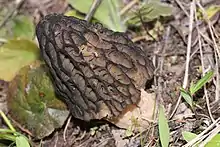
Although the majority of species within Morchella exhibit high continental endemism and provincialism,[18] several species have been phylogenetically shown to be present in more than one continent. So far, the list of transcontinental species includes M. americana, M. eohespera, M. eximia, M. exuberans, M. galilaea, M. importuna, M. populiphila, M. pulchella, M. rufobrunnea, M. semilibera, M. sextelata, M. steppicola and M. tridentina.[27][5][25][6] The reasons behind the widespread, cosmopolitan distribution of these species, are still puzzling. Some authors have hypothesized that such transcontinental occurrences are the result of accidental anthropogenic introductions,[24][18] but this view has been disputed by others, who suggested an old and natural distribution, at least for some of these species which appear to be linked to indigenous flora.[39][25] Long-distance spore dispersal has also been suggested as a possible dispersal mechanism for some species, especially those belonging to fire-adapted lineages.[61]
In popular culture
Morel hunting is a common springtime activity. Mushroom collectors may carry a mesh collecting bag, so the spores can scatter as one carries the harvest.[62]
Every spring, hundreds of morel enthusiasts gather in Boyne City, Michigan for the National Morel Mushroom Festival, a century old event.[63] As one observer stated, "if there is a modern, North American reenactment of Geoffrey Chaucer's Canterbury Tales this is it."[64] Other festivals and hunting competitions in North America include the Illinois State Morel Mushroom Hunting Championship, the Ottawa Midwest Morel Fest and the Mesick Michigan Mushroom Festival.[65]
Vernacular names
Morchella species have been called by many local names; some of the more colorful include dryland fish, because when sliced lengthwise then breaded and fried, their outline resembles the shape of a fish;[66] hickory chickens, as they are known in many parts of Kentucky; and merkels or miracles, based on folklore, of how a mountain family was saved from starvation by eating morels. In parts of West Virginia, they are known as molly moochers, muggins, or muggles. Due to the partial structural and textural similarity to some species of Porifera (sponges), another common name for any true morel is sponge mushroom. In the Appalachian woodlands, morels have also been called haystacks, or snakeheads.[62] The Finnish vernacular name huhtasieni, refers to huhta, area cleared for agriculture by the slash and burn method.[67]
The scientific name of the genus Morchella itself, is thought to have derived from morchel,[68] an old German word close to "Möhre", carrot or beet, due to similarity in shape.
Cultivation
Due to the mushroom's prized fruit bodies, several attempts have been made to grow the fungus in culture. In 1901, Repin reported successfully obtaining fruit bodies in a cave in which cultures had been established in flower pots nine years previously in 1892.[69]
More recently, small scale commercial growers have had success growing morels by using partially shaded rows of mulched wood. The rows of mulch piles are inoculated with morel mushroom spores in a solution of water and molasses which are poured over the piles of mulch and then they are allowed to grow undisturbed for several weeks. A solution of wood ashes mixed in water and diluted is subsequently poured over the rows of wood mulch which triggers fruiting of the morels. Morels are known to appear after fires and the alkaline conditions produced by wood ash mixed with water initiate fruit body formation for most species of morels. [60]
Nutrition
| Nutritional value per 100 g (3.5 oz) | |
|---|---|
| Energy | 129 kJ (31 kcal) |
5.1 g | |
| Sugars | 0.6 g |
| Dietary fiber | 2.8 g |
0.57 g | |
3.12 g | |
| Vitamins | Quantity %DV† |
| Thiamine (B1) | 6% 0.069 mg |
| Riboflavin (B2) | 17% 0.205 mg |
| Niacin (B3) | 15% 2.252 mg |
| Pantothenic acid (B5) | 9% 0.44 mg |
| Vitamin B6 | 10% 0.136 mg |
| Folate (B9) | 2% 9 μg |
| Vitamin D | 34% 5.1 μg |
| Minerals | Quantity %DV† |
| Calcium | 4% 43 mg |
| Iron | 94% 12.18 mg |
| Magnesium | 5% 19 mg |
| Manganese | 28% 0.587 mg |
| Phosphorus | 28% 194 mg |
| Potassium | 9% 411 mg |
| Zinc | 21% 2.03 mg |
| |
| †Percentages are roughly approximated using US recommendations for adults. Source: USDA FoodData Central | |
A 100g serving of morel mushrooms contains 31 calories, 5.1 grams of carbohydrates, 3.1 grams of protein, 2.8 grams of fiber, and negligible fat. Morel mushrooms are a rich source of iron and vitamin D, with moderate levels of vitamins B2, B3, B6, and manganese, phosphorus and zinc. They have low levels of calcium, potassium, and vitamins B1, B5, and folate.[70]
Gastronomical value and culinary uses
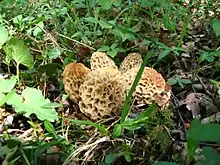
Morels are a feature of many cuisines, including Provençal.[71] Their unique flavor is prized by chefs worldwide, with recipes and preparation methods designed to highlight and preserve it.[72] As with most edible fungi, they are best when collected or bought fresh. One of the best and simplest ways to enjoy morels is by gently sauteeing them in butter, cracking pepper on top and sprinkling with salt. They are good additions to meat and poultry dishes and soups, and can be used as pasta fillings.[73] However, as morels are known to contain thermolabile toxins, they must always be cooked before eating.
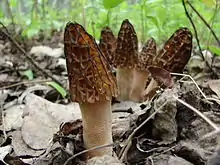
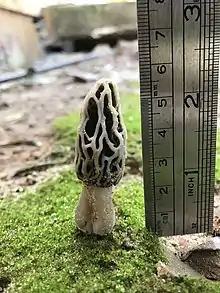
Morels can be preserved in several ways: They can be 'flash frozen' by simply running under cold water or putting them in a bucket to soak for a few minutes, then spread on a baking tray and placed into a freezer. After freezing, they keep very well with the frozen glaze for a long time in airtight plastic containers. However, when thawed they can sometimes turn slightly mushy, so they are best frozen after steaming or frying. Due to their natural porosity, morels may contain trace amounts of soil which cannot be easily washed out. Any visible soil should be removed with a brush, after cutting the body in half lengthwise, if needed. Mushroom hunters sometimes recommend soaking morels in a bowl of salt water briefly prior to cooking, although many chefs would disagree.[62]
Drying is a popular and effective method for long-term storage, and morels are widely available commercially in this form. Any insect larvae which might be present in the fruit bodies usually drop out during the drying process.[74] Dried morels can then be reconstituted by soaking for 10–20 minutes in warm water or milk, and the soaking liquid can be used as stock.[75]
The supreme flavor of morels is not just appreciated by humans; in Yellowstone National Park, black morels are also known to be consumed by grizzly bears (Ursus arctos horribilis).[76]
Toxicity
Morchella species are thought to contain small amounts of hydrazine[77] toxins or an unknown toxin that is destroyed through cooking, (the presence of hydrazine is controversial since there are no primary references of hydrazine having been detected in the species); because of this, morels should never be eaten raw.[78] It has been reported that even cooked morels can sometimes cause symptoms of upset stomach when consumed with alcohol.[79]
When eating this fungus for the first time it is wise to consume a small amount to minimize any allergic reaction. As with all fungi, morels for consumption must be clean and free of decay. Morels growing in old apple orchards that had been treated with the insecticide lead arsenate may accumulate levels of toxic lead and arsenic that are unsuitable for human consumption.[80]
False morels
When gathering morels for the table, care must be taken to distinguish them from the poisonous "false morels", a term loosely applied to describe Gyromitra esculenta, Verpa bohemica, and other morel lookalikes. Although false morels are sometimes eaten without ill effect, they can cause severe gastrointestinal upset, loss of muscular coordination (including cardiac muscle), or even death.[81][82] Incidents of poisoning usually occur when they are eaten in large quantities, inadequately cooked, or over several days in a row. False morels contain gyromitrin, an organic carcinogenic poison, hydrolyzed in the body into monomethylhydrazine (MMH).[83] Gyromitra esculenta in particular, has been reported to be responsible for up to 23% of mushroom fatalities each year in Poland.[84]
The key morphological features distinguishing false morels from true morels are as follows:
- Gyromitra species often have a "wrinkled" or "cerebral" (brain-like) appearance to the cap due to multiple wrinkles and folds, rather than the honeycomb appearance of true morels due to ridges and pits.
- Gyromitra esculenta has a cap that is usually reddish-brown in colour, but sometimes also chestnut, purplish-brown, or dark brown.
- Gyromitra species are typically chambered in longitudinal section, while Verpa species contain a cottony substance inside their stem, in contrast to true morels which are always hollow.
- The caps of Verpa species (V. bohemica, V. conica and others) are attached to the stem only at the apex (top of the cap), unlike true morels which have caps that are attached to the stem at, or near the base of the cap. The easiest way to distinguish Verpa species from Morchella species is to slice them longitudinally.[85][64]
See also
![]() Fungi portal
Fungi portal
References
- "Morchella Dill. ex Pers". Species Fungorum. CAB International. Retrieved 2014-12-11.
- Persoon CH. (1794). "Neue Versuch einer Systematischen Einteilung der Schwämme" (in German). 1: 63–128. Cite journal requires
|journal=(help) - Krombholz JV von. (1834). Naturgetreue Abblidungen und Beschreibungen der essbaren, schädlichen und verdächtigen Schwämme, Heift 3. G. Calve, Praha J, 36 p., pl. XV-XXII.
- Boudier E. (1897). "Révision analytique des morilles de France". Bulletin Trimestriel de la Société Mycologique de France. 13: 130–150.
- Richard F, Bellanger JM, Clowez P, Hansen K, O'Donnell K, Urban A, Sauve M, Courtecuisse R, Moreau PA (2015). "True morels (Morchella, Pezizales) of Europe and North America: evolutionary relationships inferred from multilocus data and a unified taxonomy". Mycologia. 107 (2): 359–382. doi:10.3852/14-166. PMID 25550303.
- Loizides, M. (2017). "Morels: the story so far". Field Mycology. 18 (2): 42–53. doi:10.1016/j.fldmyc.2017.04.004.
- Fries EM. (1822). Systema Mycologicum. 2. Lundin, Sweden: Ex Officina Berlingiana. p. 8.
- Gray SF. (1821). A Natural Arrangement of British Plants, according to their relations to each other. 1. p. 662.
- Peck CH. (1879). "Report of the Botanist (1878)". Annual Report on the New York State Museum of Natural History. 32: 44.
- Jacquetant E. (1984). Les Morilles. Paris: La Bibliothèque des Arts. p. 114.
- Jacquetant E, Bon M (1985). "Typifications et mises au point nomenclaturales dans l'ouvrage Les morilles (de E. Jacquetant), Nature-Piantanida 1984". Documents Mycologiques (in French). 14: 1.
- Boudier E. (1910). Icones mycologicae ou iconographie des champignons de France principalement discomycètes avec texte descriptif (in French). 2. Paris: Librairie des Sciences Naturelles. pp. 194–421.
- Persoon CH. (1818). Traité sur les Champignons Comestibles (in French). p. 257.
- Yoon CS, Gessner RV, Romano MA (1990). "Population genetics and systematics of the Morchella esculenta complex". Mycologia. 82 (2): 227–235. doi:10.2307/3759851. JSTOR 3759851.
- Bunyard, B.A.; Nicholson, M.S.; Royse, D.J. (1994). "A systematic assessment of Morchella using RFLP analysis of the 28S ribosomal gene". Mycologia. 86 (6): 762–72. doi:10.2307/3760589. JSTOR 3760589.
- Bunyard BA, Nicholson MS, Royse DJ (1995). "Phylogenetic resolution of Morchella, Verpa, andDisciotis (Pezizales: Morchellaceae) based on restriction enzyme analysis of the 28S ribosomal RNA gene". Experimental Mycology. 19 (3): 223–233. doi:10.1006/emyc.1995.1027. PMID 7553270.
- Kuo, M. (March 2006). "Morel Data Collection Project: Preliminary results". Retrieved 2009-05-26.
- O'Donnell K, Rooney AP, Mills GL, Kuo M, Weber NS, Rehner SA (2011). "Phylogeny and historical biogeography of true morels (Morchella) reveals an early Cretaceous origin and high continental endemism and provincialism in the Holarctic". Fungal Genetics and Biology. 48 (3): 252–265. doi:10.1016/j.fgb.2010.09.006. PMID 20888422.
- Taşkın H, Büyükalaca S, Hansen K, O'Donnell K (2012). "Multilocus phylogenetic analysis of true morels (Morchella) reveals high levels of endemics in Turkey relative to other regions of Europe". Mycologia. 104 (2): 446–461. doi:10.3852/11-180. PMID 22123659. S2CID 207685509.
- Stefani FO, Sokolski S, Wurtz TL, Piché Y, Hamelin RC, Fortin JA, Bérubé JA (2010). "Morchella tomentosa: a unique belowground structure and a new clade of morels" (PDF). Mycologia. 102 (5): 1082–1088. doi:10.3852/09-294. PMID 20943507. S2CID 6103729. Archived from the original (PDF) on 2011-07-20. Retrieved 2011-03-15.
- Kuo M. (2008). "Morchella tomentosa, a new species from western North America, and notes on M. rufobrunnea" (PDF). Mycotaxon. 105: 441–446.
- McFarlane EM, Pilz D, Weber NS (2005). "High-elevation gray morels and other Morchella species harvested as non-timber forest products in Idaho and Montana" (PDF). Mycologist. 19 (2): 62–68. CiteSeerX 10.1.1.542.4063. doi:10.1017/S0269915X0500203X.
- Harald Kellner; Carsten Renker & François Buscot (2005). "Species diversity within the Morchella esculenta group (Ascomycota: Morchellaceae) in Germany and France" (PDF). Organisms, Diversity & Evolution. 5 (2): 101–107. doi:10.1016/j.ode.2004.07.001. Archived from the original (PDF) on 2011-07-19. Retrieved 2011-03-15.
- Hatıra Taşkın; Saadet Büyükalacaa; Hasan Hüseyin Doğanb; Stephen A. Rehnerc; Kerry O'Donnell (Aug 2010). "A multigene molecular phylogenetic assessment of true morels (Morchella) in Turkey". Fungal Genetics and Biology. 47 (8): 672–682. doi:10.1016/j.fgb.2010.05.004. PMID 20580850.
- Loizides M, Bellanger JM, Lowez P, Richard F, Moreau PA (2016). "Combined phylogenetic and morphological studies of true morels (Pezizales, Ascomycota) in Cyprus reveal significant diversity, including Morchella arbutiphila and M. disparilis spp. nov". Mycological Progress. 15 (4): 39. doi:10.1007/s11557-016-1180-1. S2CID 15163613.
- Masaphy S, Zabari L, Goldberg D (2009). "New long-season ecotype of Morchella rufobrunnea from northern Israel" (PDF). Micologia Aplicada International. 21 (2): 45–55. ISSN 1534-2581.
- Du XH, Zhao Q, O'Donnell K, Rooney AP, Yang ZL (2012). "Multigene molecular phylogenetics reveals true morels (Morchella) are especially species-rich in China". Fungal Genetics and Biology. 49 (6): 455–469. doi:10.1016/j.fgb.2012.03.006. PMID 22503770.
- Pildain MB, Visnovsky SB, Barroetavena C (2014). "Phylogenetic diversity of true morels (Morchella), the main edible non-timber product from native Patagonian forests of Argentina". Fungal Biology. 118 (9–10): 755–763. doi:10.1016/j.funbio.2014.03.008. PMID 25209634.
- Kanwal HK, Acharya K, Ramesh G, Reddy MS (2010). "Molecular characterization of Morchella species from the Western Himalayan region of India". Current Microbiology. 62 (4): 1245–1252. doi:10.1007/s00284-010-9849-1. PMID 21188589. S2CID 1394087.
- Kimbrough JW. (1970). "Current trends in the classification of discomycetes". Botanical Review. 36 (2): 91–161. doi:10.1007/bf02858958. S2CID 11463562.
- Korf RP. (1972). "Synoptic key to the genera of the Pezizales". Mycologia. 64 (5): 937–994. doi:10.2307/3758070. JSTOR 3758070.
- Masaphy S, Zabari L, Goldberg D, Jander-Shagug G (Spring 2010). "The complexity of Morchella systematics: A case of the yellow morel from Israel" (PDF). Fungi Magazine. 3 (2): 14–18.
- Overholts LO. (1934). "The morels of Pennsylvania". Proceedings of the Pennsylvania Academy of Science. 8: 108–114.
- Seaver FJ. (1942). The North American cup-fungi (Operculates). Hafner Publishing C. New York. 377 p.
- Dennis RWG. (1978). Bristish Ascomycètes. Ed. Cramer, Vaduz, 585 p.
- Breitenbach J, Kränzlin F. (1984). Fungi of Switzerland, Volume 1: Ascomycetes. Verlag Mykologia, Luzern, Switzerland. 314 p.
- Weber, N.S. (1988). In A Morel Hunter's Companion, pp. 111-67. Two Peninsula Press: Lansing.
- Clowez P. (2012). "Les morilles. Une nouvelle approche mondiale du genre Morchella". Bulletin de la Société Mycologique de France (in French). 126 (3–4): 199–376 (see p. 238).
- Loizides M, Alvarado P, Clowez P, Moreau PA, de la Osa LR, Palazon A (2015). "Morchella tridentina, M. rufobrunnea, and M. kakiicolor: a study of three poorly known Mediterranean morels, with nomenclatural updates in section Distantes". Mycological Progress. 14 (13). doi:10.1007/s11557-015-1030-6. S2CID 16132175.
- Kuo M, Dewsbury DR, O'Donnell K, Carter MC, Rehner SA, Moore JD, Moncalvo JM, Canfield SA, Stephenson SL, Methven AS, Volk TJ (2012). "Taxonomic revision of true morels (Morchella) in Canada and the United States". Mycologia. 104 (5): 1159–1177. doi:10.3852/11-375. PMID 22495449. S2CID 45219627.
- Işiloğlu M, Alli H, Spooner BM, Solak MH (2010). "Morchella anatolica (Ascomycota), a new species from southwestern Anatolia, Turkey". Mycologia. 102 (2): 455–468. doi:10.3852/09-186. PMID 20361512. S2CID 34185312.
- Elliott TF, Bougher NL, O'Donnell K, Trappe JM (2014). "Morchella australiana sp. nov., an apparent Australian endemic from New South Wales and Victoria". Mycologia. 106 (1): 113–118. doi:10.3852/13-065. PMID 24603835. S2CID 42830021.
- Clowez P, Alvarado P, Becerra M, Bilbao T, Moreau PA (2014). "Morchella fluvialis sp. nov. (Ascomycota, Pezizales): A new but widespread morel in Spain". Boletín de la Sociedad Micológica de Madrid. 38 (2): 251–260.
- Clowez, Philippe; Bellanger, Jean-Michel; de la Osa, Luis Romero; Moreau, Pierre-Arthur. (2015). Morchella palazonii sp. nov. (Ascomycota, Pezizales) : une nouvelle morille méditerranéenne. Clé des Morchella sect. Morchella en Europe. Documents Mycologigues XXXVI: 71–84.
- Voitk A, Beug M, O'Donnell K, Burzynski M (2016). "Two new species of true morels from Newfoundland and Labrador: cosmopolitan Morchella eohespera and parochial M. laurentiana". Mycologia. 108 (1): 31–37. doi:10.3852/15-149. PMID 26553777. S2CID 21363047.
- Taşkın, H.; Doğan, H.; Büyükalaca, S.; Clowez, P.; Moreau, P.-A.; O'Donnell, K. (2016). "Four new morel (Morchella) species in the elata subclade (M. sect. Distantes) from Turkey". Mycotaxon. 131 (2): 467–482. doi:10.5248/131.467.
- Clowez, P.; Marcos Martinez, J.; Sanjaume, R.; Marques, G.; Bellanger, J. M.; Moreau, P. A. (2020). "A survey of half-free morels in Spain reveals a new species: Morchella iberica sp. nov. (Ascomycota, Pezizales)". Ascomycete.org. 12 (1). doi:10.25664/art-0291.
- Buscot F, Roux J (1987). "Association between living roots and ascocarps of Morchella rotunda". Transactions of the British Mycological Society. 89 (2): 249–252. doi:10.1016/s0007-1536(87)80162-6.
- Buscot F (1992). "Mycorrhizal succession and morel biology". In Read DJ, Lewis DH, Fitter AH, Alexander IJ (eds.). Mycorrhizas in Ecosystems. Wallingford, United Kingdom: CAB International. pp. 220–224. ISBN 978-0-85198-786-6.
- Dahlstrom JL, Smith JE, Weber NS (2000). "Mycorrhiza-like interaction by Morchella with species of the Pinaceae in pure culture synthesis". Mycorrhiza. 9 (5): 279–285. doi:10.1007/PL00009992. S2CID 36119264.
- Tedersoo L, May TW, Smith ME (2010). "Ectomycorrhizal lifestyle in fungi: global diversity, distribution, and evolution of phylogenetic lineages". Mycorrhiza. 20 (4): 217–263. doi:10.1007/s00572-009-0274-x. PMID 20191371. S2CID 3351967.
- Lincoff GH. (1981). The Audubon Society Field Guide to North American Mushrooms. p. 326.
- Du XH, Zhao Q, Yang ZL (2015). "A review on research advances, issues, and perspectives of morels". Mycology. 6 (2): 78–85. doi:10.1080/21501203.2015.1016561. PMC 6106076. PMID 30151316.
- Taşkın H, Doğan HH, Büyükalaca S (2015). "Morchella galilaea, an autumn species from Turkey". Mycotaxon. 130: 215–221. doi:10.5248/130.215.
- Loizides M. (2011). "Morchella rufobrunnea, η μορχέλλα της πόλης" [Morchella rufobrunnea, the urban morel]. Μυκητολόγος [Mycologist] (in Greek). 5: 10–13.
- Pilz, D.; R. McLain; S. Alexander; L. Villarreal-Ruiz; S. Berch; T.L. Wurtz; C.G. Parks; E. McFarlane; B. Baker; R. Molina; J.E. Smith (March 2007). Ecology and management of morels harvested from the forests of western North America. General Technical Report PNW-GTR-710. Portland, OR: U.S. Forest Service Pacific Northwest Research Station.
- Mihail JD, Bruhn JN, Bonello P (2007). "Spatial and temporal patterns of morel fruiting". Mycological Research. 111 (3): 339–346. doi:10.1016/j.mycres.2007.01.007. PMID 17363234.
- Greene DF, Hesketh M, Pounden E (2010). "Emergence of morel (Morchella) and pixie cup (Geopyxis carbonaria) ascocarps in response to the intensity of forest floor combustion during a wildfire". Mycologia. 102 (4): 766–773. doi:10.3852/08-096. PMID 20648745. S2CID 28400225.
- Wurtz TL, Wiita AL, Weber NS, Pilz D (2005). Harvesting morels after wildfire in Alaska (Report). Research Note RN-PNW-546. Portland, Oregon: U.S. Forest Service Pacific Northwest Research Station. Archived from the original on 2011-09-28. Retrieved 2009-05-26.
- "YouTube". YouTube Growing Morels. 2019-11-08. Retrieved 2019-11-11.
- Du XH, Zhao Q, Yang ZL, Hansen K, Taşkın H, Büyükalaca S, Dewsbury D, Moncalvo JM, Douhan GW, Robert VA, Crous PW, Rehner SA, Rooney AP, Sink S, O'Donnell K (2012). "How well do ITS rDNA sequences differentiate species of true morels (Morchella)?". Mycologia. 104 (6): 1351–1368. doi:10.3852/12-056. PMID 22802394. S2CID 6740906.
- Excerpts from the book Animal, Vegetable, Miracle, by Barbara Kingsolver.' Animal, Vegetable, Miracle. Harper Perennial. pp. 77–80.
- "National Morel Mushroom Festival". bcmorelfestival.com. Retrieved 2018-08-10.
- Kuo M. (2005). Morels. Ann Arbor, Michigan: University of Michigan Press. p. 173. ISBN 978-0-472-03036-1.
- https://www.mesick-mushroomfest.org/schedule.html. Missing or empty
|title=(help) - Lincoff G. (2011). The Complete Mushroom Hunter: An Illustrated Guide to Finding, Harvesting, and Enjoying Wild Mushrooms. Quarry Books. p. 57. ISBN 978-1-61058-099-1.
- Cunningham AB, Yang X (2012). Mushrooms in Forests and Woodlands: "Resource Management, Values and Local Livelihoods". Routledge. p. 180. ISBN 978-1-136-53817-9.
- Burnett GT. (1835). Outlines of Botany: Including a General History of the Vegetable Kingdom, in which Plants are Arranged According to the System of Natural Affinities. John Churchill. p. 241.
- Repin C. (1901). "Sur la culture de la Morille". Revue générale des sciences pures et appliquées. 12: 595–96. Retrieved 2010-03-21.
- "Nutrition facts for Mushrooms, raw, morel, recommended daily values and analysis". Nutritional Values For Common Foods And Products. Retrieved 2019-11-04.
- Olney R. (1995). A Provencal Table. London: Pavilion. pp. 31–32. ISBN 978-1-85793-632-2.
- Acton J, Sandler N (2007). Mushroom. Watermill Books. p. 160. ISBN 978-1856267397.
- Wright J. (2007). Mushrooms: River Cottage Cookbook 1. Bloomsbury. p. 256. ISBN 9780747589327.
- Wild About Mushrooms: Morels. Mssf.org. Retrieved on 2012-04-17.
- Carluccio A. (2003). The Complete Mushroom Book. London, UK: Quadrille. pp. 37–38, 96–97. ISBN 978-1-84400-040-1.
- Mattson DJ, Podruzny SR, Haroldson MA (2002). "Consumption of fungal sporocarps by Yellowstone grizzly bears". Ursus. 13: 95–103. JSTOR 3873191.
- Stamets P. (2005). Mycelium Running. Berkeley: Ten Speed Press. p. 344.
- Hall IR, Buchanan PK (2003). Edible and Poisonous Mushrooms of the World. Timber Press. ISBN 978-0-88192-586-9.
- Groves JW. (1964). "Poisoning by morels When taken with alcohol". Mycologia. 56 (5): 779–780. doi:10.2307/3756634. JSTOR 3756634.
- Shavit E, Shavit E (Spring 2010). "Lead and arsenic in Morchella esculenta fruitbodies collected in lead arsenate contaminated apple orchards in the northeastern United States: A preliminary study" (PDF). Fungi Magazine. 3 (2): 11–18.
- Michelot D, Toth B (1991). "Poisoning by Gyromitra esculenta—a review". Journal of Applied Toxicology. 11 (4): 235–243. doi:10.1002/jat.2550110403. PMID 1939997.
- Bresinsky A, Besl H. (1990). A colour atlas of poisonous fungi. Wolfe Publishing Ltd, London.
- Karlson-Stiber C, Persson H (2003). "Cytotoxic fungi—an overview". Toxicon. 42 (4): 339–349. doi:10.1016/S0041-0101(03)00238-1. PMID 14505933.
- Lampe KF. (1979). "Toxic fungi". Annual Review of Pharmacology and Toxicology. 19 (1): 85–104. doi:10.1146/annurev.pa.19.040179.000505. PMID 378111.
- Kuo M. (2007). 100 Edible Mushrooms. Ann Arbor, Michigan: The University of Michigan Press. pp. 55–58. ISBN 978-0-472-03126-9.
External links
| Wikimedia Commons has media related to Morchella. |
